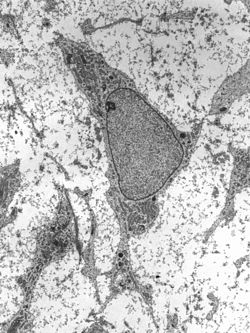Somatic stem cell
| Adult stem cell | |
|---|---|

Transmission electron micrograph of an adult stem cell displaying typical ultrastructural characteristics.
|
|
| Details | |
| Identifiers | |
| Latin | Cellula praecursoria |
| TH | H1.00.01.0.00035 |
|
Anatomical terms of microanatomy []
|
|
Adult stem cells are undifferentiated cells, found throughout the body after development, that multiply by cell division to replenish dying cells and regenerate damaged tissues. Also known as somatic stem cells (from Greek Σωματικóς, meaning of the body), they can be found in juvenile as well as adult animals and humans, unlike embryonic stem cells.
Scientific interest in adult stem cells is centered on their ability to divide or self-renew indefinitely, and generate all the cell types of the organ from which they originate, potentially regenerating the entire organ from a few cells. Unlike for embryonic stem cells, the use of human adult stem cells in research and therapy is not considered to be controversial, as they are derived from adult tissue samples rather than human embryos designated for scientific research. They have mainly been studied in humans and model organisms such as mice and rats.
A stem cell possesses two properties:
Hematopoietic stem cells are found in the bone marrow and umbilical cord blood and give rise to all the blood cell types.
Mammary stem cells provide the source of cells for growth of the mammary gland during puberty and gestation and play an important role in carcinogenesis of the breast. Mammary stem cells have been isolated from human and mouse tissue as well as from cell lines derived from the mammary gland. Single such cells can give rise to both the luminal and myoepithelial cell types of the gland, and have been shown to have the ability to regenerate the entire organ in mice.
...
Wikipedia
